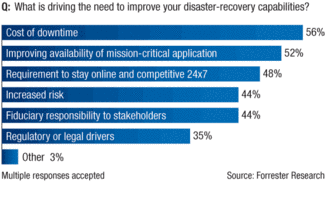As businesses and consumers literally take to the clouds — both public and private — in coming years, storage vendors will continue to find a vital growing market for their goods, according to a new report.
In June, analyst firm IDC said it sees users’ data doubling every two years.
Now, in a new report, IDC projects strong sales of storage products through 2015 as movement to cloud environments triggers swelling demand for someplace for all that data to go.
Indeed, IDC foresees that by 2015, global sales of storage for both public and private clouds will hit $22.6 billion annually.
“Despite current economic uncertainties, IDC expects cloud service providers — both public and private — to be among the most expansive spenders on IT products and services as they continue to build out their facilities worldwide and expand their service options,” Richard Villars, vice president of storage systems and executive strategies at IDC, said in a statement.
In fact, public cloud service providers’ spending on storage hardware, software, and professional services is likely to swell at a compound annual growth rate (CAGR) of 23.6 percent between 2010 and 2015, according to IDC figures.
Meanwhile, spending by enterprises on private cloud storage during the same period will likely expand at a CAGR of 28.9 percent, according to the new report.
IDC latest report said that the biggest driver of storage consumption over the past three years has been public cloud-based application and infrastructure providers. Many of these are what IDC refers to as “content depots” like iTunes, Netflix, YouTube, and Facebook.
Those types of organizations are basically in the business of gathering, organizing, and making available large amounts of digital content.
A second category of cloud purveyors are so-called “as-a-service” providers of IT infrastructure such as Salesforce.com, Amazon Web Services, and WebEx Connect, all of which require huge repositories for data and, thus, data centers and storage.
Added to that are myriad private cloud environments that require applications, compute power, and content storage for business, education, and governmental organizations, including government and research sites.
By IDC’s reckoning, both public and private cloud providers have a set of five information requirements that are propelling storage demands.
First, they need to constantly deliver information and applications more quickly. They also need to drive down upfront infrastructure investments in order to speed IT deployments while lowering costs.
Another requirement is to minimize unpredictable, or “bursty,” workloads, while finding ways to lower or distribute ongoing expenses related to long-term data archival. They will also have to deliver near-continuous, real-time analysis of large volumes and wide varieties of so-called Big Data.
“The challenge facing the storage industry will be to balance public cloud service providers’ demand for low-cost hardware while boosting demand for advanced software solutions in areas such as object-based storage, automated data tiering, Big Data processing, and advanced archiving services,” Villars added.





